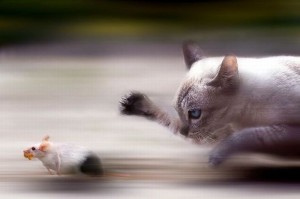 Capturing a quickly moving subject as if it is suspended in time is definitely a skill desired by any serious photographer. In fact, it’s a bit of a necessary skill for anyone who wants in on capturing some great “leisure diving†photos (this season’s current follow-up to the planking trend). However, as any great graphic designer knows, creativity and diversity are components of any quality profile. Because of this, taking a bit of a less traditional approach to motion photography can actually enhance the skills and portfolio of any photographer or graphic designer. “Smooth/blurred motion†photography focuses on allowing fast motion to go unfrozen, and instead creates photographs where the subject is “smoothly†moving.
Capturing a quickly moving subject as if it is suspended in time is definitely a skill desired by any serious photographer. In fact, it’s a bit of a necessary skill for anyone who wants in on capturing some great “leisure diving†photos (this season’s current follow-up to the planking trend). However, as any great graphic designer knows, creativity and diversity are components of any quality profile. Because of this, taking a bit of a less traditional approach to motion photography can actually enhance the skills and portfolio of any photographer or graphic designer. “Smooth/blurred motion†photography focuses on allowing fast motion to go unfrozen, and instead creates photographs where the subject is “smoothly†moving.
Mastering “smooth/blurred motion†photography, is however, not as simple as creating a blurry photograph. In fact, the artistic distinctions between poor, blurry photography and a quality smooth motion photograph are grand. Here are some essential guidelines for capturing unique, creative, and lovely smooth motion photographs.
First, be sure to recognize the appropriate setting. Smooth motion photography shouldn’t be used for just any motion-related activity. Instead, this method tends to work best when there is a dark background and relatively little light in the arena. Since capturing such photographs require you use a longer than normal shutter speed, any extra light will make the moment overly bright. Additionally, the subjects should be wearing distinct, brightly colored clothing in order to make sure that their movements stand out from everything else. Finally, make sure that you are shooting in a situation where the subject is the primary object/person that is moving; the background itself need to be void of movement, or else the photograph will appear as a poor quality, blurry picture.
Secondly, recognize the desired mood. Overall, smooth/blurred motion photographs look best when used for graphics focused on creating a more of a pathos related (emotional appeal) goal for the target audience. While frozen motion photographs are generally used to create a sense of “awe†and focus on the success of the subject (dunking a basketball, leaping in the air, doing a handspring, etc.), smooth motion photography is best for artsy, emotionally inspiring graphics. Ideal smooth motion photograph opportunities include dance concerts/recitals as well as nighttime (outdoor) sporting events.
Finally, be sure to have the proper equipment on hand. A longer shutter time combined with a moving subject creates a potential for unwanted blurriness in your photos. Avoid this by bringing a steady tripod; often the difference between a lovely smooth motion photograph and a common, blurry photo is the presence of absence of a shaky hand.
For a clearer idea of how a smooth motion photograph can express a moment in a way still-motion never could, check out these lovely photos of dancers here and here.


